
One of the most uniquely American aspects that came as a byproduct of monopolization of the Hollywood studios and their influence over the systems of distribution, before the Paramount Decree that stripped them of their theaters and strict control over distribution, is the B movie. Initially the term referred to the less-known half of a double feature (similar to the B-sides that were overshadowed by the hits on vinyl singles), but it eventually reached a much broader usage in the latter half of the last century, becoming a bit of an umbrella term for lower budget commercial films. The connotations usually entail lower production values, formulaic or overly absurd plots, utilization of unknown actors, and a usually negative assumption of a lack of artistry or genuine creativity fueled by imitations of cookie cutter genre forms (usually associated with horror films). However, these expectations are quite vague for an already widely used and not always specific term that contains half a century’s worth of different films categorized under it.
The history of this category of movies has been well researched and documented by academics who have analyzed it from socio-economic and socio-cultural standpoints, creating developed timelines of the transitions and changes in the grander realm of lower budget productions that cross over into the history behind the golden gates of Hollywood at many points (especially towards the 1970s, off of the heel of the various exploitation eras) as well as even coining terms such as “C movie” and “Z movie” that codify the categorizations even further. Amidst all the lovely academic work done by many writers and researchers, which is vastly superior to that of mine, this specific blog will look into the mostly overlooked and still uncategorized within online encyclopedias or knowledge/information banks and databases: the 8th and most contemporary wave of B movies of the 2000s to 2010s.
Following the trends of ultra-low budgets in the 1990s independent scene, from a Western (specifically North American) standpoint, a number of filmmakers and creative ideals would be elevated into the limelight (e.g. Tarantino, violence as both stylized and darkly humorous). Simultaneously, new advances in technology had continued to allow the usually cruder looking aesthetics of tape and digital cameras to reach a higher grade of quality, raising them to a step above the secular and personal usage that they had mostly seen, as well as granting them greater accessibility and ease of use. Independent creators totally removed from the trappings of the independent scene as well as the most average and non-artistically driven of all people now had the tools to create decent looking films on their own or with small crews of friends and family. Through the aughts and into the 2010s, this trend would grow on an exponential scale with the continued bettering of technology and the creation of online channels, which would foster connections and communities of these creators, as well as virtual spaces that could host finished products, such as YouTube and Vimeo.
Aided by a long history of cinema that fostered many aspects of the Western zeitgeist and created cultural moments as well as aspects of understanding art (mostly popular art in this case) as well as the crossover into media (made super saturated with the aforementioned power of the internet), many of the filmmakers who contributed to the era of films we are looking at have done so through a lens of self-awareness that acknowledges the lineage of the no-budget and “low taste” films of days prior, effectively creating an even longer lineage of semi-meta commentary and parody that I think is a fascinating phenomenon. However, there are also a number of those blinded by dreams of fame, who seem to think that they truly are the next great artist. The following section will look at a chronological timeline of some of the most unknown, schlockiest, and cheapest movies of about the last twenty-five years.
Jack Frost (1997)
Although this blog entry’s mission is to focus on the aughts and 2010s, it seems fitting to start with a film that was released right before the ballooning fears of the Y2K bubble reached everyone’s desktop computers and the desire for war overseas had infiltrated the households of the ignorant on a widespread level.
Michael Cooney’s campy, black comedy slasher Jack Frost is a film that feels like the swan song of a bygone era. Not only did it follow the lineage of the many Christmas-themed slasher films that came before it (i.e. Black Christmas, Silent Night Deadly Night), especially in the overt as well as unintended humor, it also rode a specific cultural moment in mass media marketing. Not only did Cooney draw inspiration from the iconic Campbell’s soup commercial, which has been a touchstone in recognizing the VHS aesthetic era of nostalgia (rooted in commercialism through televised ads) that resides within the hearts of most millennials, but his film preceded Troy Miller’s film of the same name by a whole year and caused plenty of confusion for parents at the rental store checkout line.
Many of the children who saw the film by accident must have enjoyed it since, as the film has garnered a fairly large cult following since release. There is plenty to love about this film, after all, from uniquely comical death scenes caused by clunky interactions between the practical snowman murderer and the human actors to a heap of fairly chuckle-worthy snow- and snowman-related puns. The film can even feel endearing at times, with a cast of characters enjoying the holidays the best they can in their backwater town amidst the terror of a serial killer whose soul has spark.
The Room (2003)
It partially feels like sacrilege to mention Wiseau’s directorial masterpiece, The Room, which has built such a large cult following in the internet both in the early aughts as well as in the mid-2010s that it led to not only David Franco’s acclaimed 2017 film The Disaster Artist (adapted from Greg Sestero’s book of the same name) but also the widespread tradition of the film being watched in theaters (including ours) by fans who have built jokes around all that is wrong with the movie. The jokes range from highlighting the amateurish cinematography and use of establishing shots to throwing spoons, which refers to one specific piece of bad production design. Although this film still exists as the grand example of the kind of following and life that a movie this objectively bad can have years after the fact, The Room will serve here as a turning point that will lead us into the even smaller, the more amateurish, and the even more independent.
The film follows Johnny (Wiseau), who purportedly has almost superhuman attractiveness, intelligence, and emotional maturity (details penned in the script by Wiseau himself), as the woman to whom he has dedicated his life becomes disloyal and has an affair with his best friend, Mark (Sestero), behind his back. Many of the jokes repeated by regulars at screenings, such as the monthly ones held by The Frida, are based upon the most comically bad aspects of the film, like the acting of most all the actors involved and especially of Wiseau. Amidst the string of events that apparently tie one scene to the next, there is no discernible plot that carries audiences throughout, and characters are introduced left and right as if they’ve been present the entire time. What makes the aforementioned goofs all the more fascinating and special is the background context provided by The Disaster Artist, both the book and the film, and Wiseau and others’ lack of understanding about how to make a movie.
Suburban Sasquatch (2004)
Dave Wascavage’s film Suburban Sasquatch is one of my personal favorites on this list, and it recently resurfaced to a fresh audience via YouTube videos of people reacting to the quality of the film, such as that of RedLetterMedia from a few years back. This extremely low, practically no-budget film made in the woods of Pennsylvania follows the chaos caused by a bloodthirsty sasquatch in a suburban area, which is where Wascavage seems to articulate his critique of the destruction caused by the birth of modernized society and the façade of suburbanism. It is hard to take such messages seriously, as the low-effort effects and many murder scenes play out before the monster is hunted down by a mystical Native American warrior who teams up with a wannabe reporter to fight the beast.
The film treats the audience to a slew of very amateurish non-actors, a consistently crude yet somewhat comical sasquatch suit, and very cheap special effects for gore and blood, as well as Wascavage’s own home-brewed CGI that is dispersed throughout the film. One thing that makes this film fascinating is the DVD special features and commentary, in which Wascavage talks monotonously yet semi-endearingly about his attempts to create his own horror film rife with political messaging. It does seem jarring, putting the commentary side by side with the film itself, and it makes one question whether the director knew what was appearing on camera during shooting. What makes Wascavage and this film still special to this day, however, is Troubled Moon Films. This independent company, proudly owned and operated by Wascavage, declares itself to be an “Independent Z Grade movie making studio” on the front page of its still-active website and houses all the information about — as well as products related to — movies by Wascavage.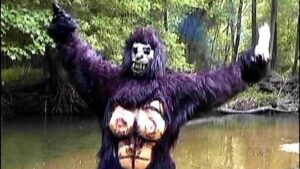
The Gingerdead Man (2005)
Charles Band’s film The Gingerdead Man is a classic from the esteemed contemporary B-movie director under his production company, Full Moon Features. Not only does the movie briefly star Gary Busey in person (during a bit of a slump in his career), but it also features his voice and raunchy one-liners throughout the majority of the film as he inhabits the form of a gingerbread man who takes his revenge on a baker and company stuck within the bakery. It is a sweet-tasting spin on the “murderer’s soul moves to another vessel and wreaks havoc” trope, taking most of its creative cues from the Child’s Play franchise. Although the acting is atrociously bad, and the horn-heavy score becomes a chore to listen to, there’s a constant humor as well as subtly intentional camp that pairs extremely well with one of the most uniquely brash horror movie villains of the last thirty years.
The film follows Sarah as she attempts to run the family bakery in the wake of tragedy caused by the recently executed Millard Findlemeyer (Busey). Upon finding a mysterious package of gingerbread spice mix, the bakery employees decide (using the average intelligence level of horror movie characters) to use said mix to make gingerbread cookies. The dough accidentally becomes contaminated with human blood from an employee, and when cooked, it becomes a vessel for the evil soul of the murderer Findlemeyer, who unleashes his wrath on Sarah and some unsuspecting troublemakers.
While most of the film is quite forgettable, largely due to a lack of interesting performances from the actors, most any scene with the titular gingerbread character is memorable. Sometimes it is due to the lame yet hilarious lines lazily delivered by Busey, and other times due to the absurd context of the moment. My personal favorite is The Gingerdead Man’s encounter with a rat in the bakery, which prompts him to deliver one of the greatest lines of the film: “I’m gonna kick your little rat ass.” Why this role didn’t bring home a prestigious award for this well-known actor is beyond anyone’s comprehension.
Double Down (2005)
No list regarding B movies in the aughts would be complete without mentioning the self-sufficient maestro of the extreme low-budget film, Neil Breen. While many will reference the humor in Wiseau’s constant credits during the opening credits for The Room, a look at the list of Breen’s roles in his own films stumps that by far.

Here, we will acknowledge the film that started the legacy, Double Down. The film follows Breen in the lead role as Aaron Brand, a hacker who has superhuman abilities to fight for or against the corrupt institutions of the world and has been tasked with shutting down the Las Vegas strip. He not only does so but also fights off terrorist attacks and drug lords while also battling his depression-fueled agony and hallucinations related to the death of his wife. In the wake of a recently post 9/11 America, the plot seems vaguely critical of the power and corruption of the United States, yet also anti-terrorist. The fact of being posited at such a culturally hectic moment seems to have had a slight influence on the half-conscious antics of Breen’s protagonist.
Many have talked about Breen in the same vein as they tend to do Wiseau—as extremely naive persons who create with a complete lack of self-awareness or at least an internal refusal to realize the quality of their tastes and the work they make. Breen might not have a thick European accent, but his usually inarticulate ramblings about his work and his monotone voice, which is the most oft-heard voice of dialogue in his films, have become iconic in their own rights. Not only have the films and the filmmaker gained an online cult following with the help of the rise of absurdist humor on the internet, especially in places like YouTube, but many have anxiously awaited his upcoming, untitled 6th film, which he has recently given a mysterious update on.

Evil Bong (2006)
Charles Band, for all the right reasons, is a repeat offender on this list. Following the antics of The Gingerdead Man, Band conceived of and started shooting his stoner antics-filled horror movie, Evil Bong, within an extremely short window of time. It becomes quite visible in the lack of varied set locations as well as the padding that the movie attempts the drawn out and overused jokes that might have once worked with the unique personalities of characters such as Cheech and Chong but are made senseless here.
The film follows a group of roommates, all of whom are stoners save for the flat and stereotyped nerdy character, who decide to get a bong for the apartment. They buy an enormous and overly ornate bong that turns out to be haunted, and it turns the tables and smokes the smokers as it begins to steal the souls of those who use it. The movie seems to partly be a parody of the anti-reefer sentiments, as the bong transports its victims to a seedy, ultra-hedonistic paradise in the form of a strip club that seems to be posited as the dream world of every stoner.
The very premise of the film itself seems like the sort of idea or thought that would pop into the head of a stoner before being shared with the rest of their friends around a bong or shared joint: “What if, like, a bong was, like, evil and trapped people inside of it before killing them, although they’re not really dead and are actually alive but need to be rescued. And one of the guys dies by an evil stripper with goth boobs and another by the Gingerdead Man.” No joke on the cameo, by the way. The Gingerdead Man makes a killer entrance during a trapped dream sequence and fleshes out the Band multiverse of monster villains. Brilliant stuff.
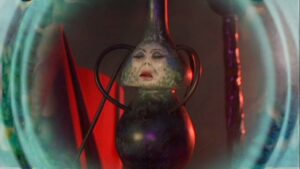
Ratatoing (2007)
Michelle Gabriel’s very coincidentally-timed animated film, Ratatoing, hit shelves directly around the same time as another big movie regarding a rat chef and consequently falls into a large and still-growing category of films that are considered very obvious rip-offs of larger films (usually animated and or children’s movies) that has been very explored by creators of “review” and “react” content on sites such as YouTube. Alongside contemporaries such as Plan Bee and The Little Panda Fighter, it seems to have no shame in its plight to capitalize on the possible confusion between titles, nor does it put forth much effort in the quality of the animation let alone the complete lack of originality.
The movie opens with a narration of the title by a deep-voiced narrator before a cheaply made, French-sounding score, nearing an imitation of the Disney source material, plays over opening credits… before we learn that the film takes place in Brazil. The protagonist of this story is Marcel Toing, a famous rat chef who owns a very respected restaurant. The scenery of the first twenty minutes does not change as Toing stirs a can of liquid and customers order food. The film eventually reaches a loose plot about the secret recipes of Chef Toing being stolen, but it all ends up as an incoherent mess that the animation does not make easier to digest. The crude animation is one of the hardest aspects to deal with, barely made up for by the voice acting done so sincerely by the voice actors inhabiting the anthropomorphic characters.
While the references to the mouse who has been the mascot for the company responsible for the film which Ratatoing steals its cues from aren’t inherently funny, and the self-awareness feels wrong in a movie made to be misleading to parents of children, the misadventures of rat Marcell Toing make for great entertainment when watched in a non-sober state with friends.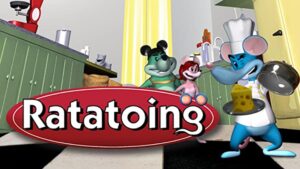
ThanksKilling (2008)
Jordan Downey’s slasher horror film ThanksKilling is another personal favorite and a very appropriate film for the time of year we are currently in. This movie is one of the most unique of those present on this list, as it doesn’t stray away from elements of black comedy (similar to those present in Jack Frost) but also takes advantage of its situation to be self-aware about its own quality. This becomes much more apparent and meta in the sequel of much higher production quality, ThanksKilling 3, which purports that the original sequel to ThanksKilling was lost and a team of friends (including the titular Turkie character) sets out to recover it.
Even so, Downey plays into the camp from the very beginning of the original ThanksKilling entry. The film, long before the slow pull out from a colonoscopy that the Safdie brothers presented us with in their current opus, Uncut Gems, opens on an extreme close-up of a female nipple. This is revealed to belong to a pilgrim woman who is on the run from an unseen force as screams can be heard in the distance. After fleeing and tripping, the film wastes no time in revealing the rubber puppet of Turkie that we will see acting as a harbinger of death for the length of the film. After Turkie murders the woman and brings on the opening title and credit sequence, we are transported to the modern day and introduced to the set of characters who will fight this demented, murderous comedian of a turkey while the rest of the town prepares for the Thanksgiving festivities.
Amidst the low-resolution footage and cheap props, ThanksKilling leaves viewers with more laughs (both intentional and unintentional) than anything else. It remains one of the more quotable movies on this list, with classic lines such as “Gobble Gobble, Motherfucker!” and “Pull your shirt down, honey! It’s Thanksgiving, not Titsgiving!” popping up like treats for the audience.
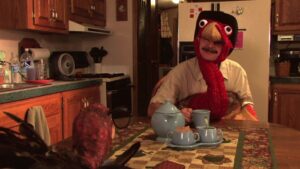
Birdemic: Shock and Terror (2010)
James Nguyen’s well-known first installment in the Birdemic trilogy also feels like a bit of a cheap or easy mention, as it took the internet by storm not long after its release due to slews of videos made about the film by various content creators on sites like YouTube. However, it feels necessary to mention, not only for its importance in the timeline but also because we played the third film in the series, Birdemic 3: Sea Eagle, this past weekend, with Nguyen hismelf even coming on out for a Q&A after the film.
The film that started it all, Birdemic: Shock and Terror, follows protagonist Rod, who is a budding software salesman who falls for an up-and-coming model Nathalie. The two hit it off after having a shabby Thai food dinner and cutting up a rug on a barren dance floor while serenaded by a singer who quite possibly overpaid for voice lessons. Just as everything seems fine and dandy for the two, the world falls to pieces, and Nguyen goes into full swing with his inspiration from Hitchcock’s The Birds as droves of eagles begin to attack people on the mainland. Ron, Nathalie, and their ex-Marine friend Ramsey (Adam Sessa) fight off birds and survive, picking up two children whose parents were murdered along the way.
Birdemic holds nothing back and unleashes very obviously bad acting, CGI eagles, audio mixing, and cinematography as it pushes a seemingly nonsensical and incoherently vague message about the perils caused by global warming and human interference with nature. The absolute absurdity of this amalgamation of issues has been one of the most attractive aspects of the film for many viewers, as there is never a shortage of things which one can laugh at.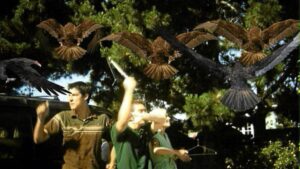
The Amazing Bulk (2012)
Lewis Schoenbrun’s The Amazing Bulk is a unique case on this list, as the director has worked in the editorial departments of popular or high-quality cult classic films of the 1980s, such as Jay Levey’s UHF and Donald Petrie’s Mystic Pizza before directing and/or editing movies similar to the others on this list, such as Dr. Chopper. What can easily be considered his magnum opus, The Amazing Bulk exists between the spaces of parody as well as naively bad filmmaking. Not only is it very obviously a parody or “mockbuster” of the Incredible Hulk movies and media, but it also matches the same low level of production value and quality as the director’s previous movies.
One technique used extensively in the film, similar to the expensive superhero movies of our current moment, is CGI. Although the CGI included in the multimillion-dollar productions of these multimillion-dollar companies tends to be of a low quality for a wide variety of reasons, the CGI in Amazing Bulk is horrifically bad. The unfortunate part is that it is present within just about every single shot of the film. All of the environments in which the titular purple monster moves his juicy rear and the human actors awkwardly pretend to walk as if acting in a Tim and Eric sketch are fabricated with poorly constructed CGI. This extends to the slew of effects present, from gunshots to military vehicles to running sequences, and it becomes difficult to tell which part of the film exists as satirical commentary on the era of superhero films and which parts are genuine intent on the part of Schoenbrun.
The film follows scientist Henry “Hank” Howard on a commissioned experiment to create a serum that increases the strength and longevity of the user, and he injects himself with the serum in order to prove its capacity, which leads him to become the titular purple, humanoid creature. His power to become the monster further complicates his relationship with his fiancée, daughter of General Darwin, who seeks to eventually destroy Hank and the project. While the painfully crude visuals and the plot that is so formulaic that it no longer feels like parody will accompany the laughs at the absurdity, the extensive use of stock footage and graphics from the internet may infuse most with a feeling of dread regarding the B movies of the new media era.
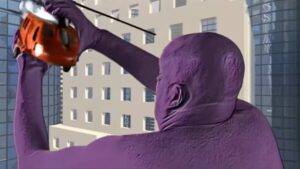
Zoombies (2016)
Glenn Miller’s animal virus horror movie, Zoombies, checks off the box of another subsection of contemporary B movies — in this case, the “made for TV” section. Made for television viewing, Zoombies exists in the same realm as films from channels like Syfy, which make films such as Sharknado and Piranhaconda, in which there is a higher-than-average production value compared to the other films on this list, yet an abundance of amateur performances, absurd and usually cheap plots, and horrendously (but sometimes seemingly intentionally bad) CGI monsters.
The film follows a group of characters, who predictably end up as stereotyped and quite annoying as such thinly-written characters often do, as they embark on a tour at a top-of-the-line safari park. During their time inside, a deadly virus spreads throughout the park and infects the animals before turning them into violent zombies that attack the guests. Robbing many cues from Spielberg’s Jurassic Park, the gang attempts to stick together and survive the onslaught while also keeping the animals from escaping and getting into the city.
While these films can be quite hit-or-miss in terms of enjoyability, as the level of self-awareness and humor can be very slim, Zoombies delivers a fun mix of late-night TV sleaze with a string of inspiration from the history of B movies that focused on the spread of infectious diseases that change the behaviors of people or animals and the thriller creature features. One of the most interesting facets of the film is the usually-abrupt switches between CGI and practicals. While most of the set pieces look decent for what they are, the animals can be one of the more difficult things to look at. One sequence in particular that features a chase and fight with an infected gorilla (which is very obviously inspired by the infamous raptor scene of Jurassic Park) features a fairly cheap-looking gorilla costume that changes into a CGI gorilla, depending on the content of the shot. All in all, Zoombies delivers enough half-decent suspense and humorous gore to keep viewers enticed until the end.

Santa Jaws (2018)
Misty Talley’s film Santa Jaws may be the second Christmas-themed movie, the second made for TV movie, and the third holiday-based movie on this list, yet it is most definitely not the least of them all. This Syfy original movie is runs in a similar vein to those aforementioned, creating an absurd monster that combines one animal with another animal or some other aspect and terrorizes the characters with said monster.
Santa Jaws may follow in the completely absurd antics of over-the-top monster terror as the many similar films that have preceded it, but it also takes inspiration from the many generations of Christmas movies both popular and made for TV (such as those on the Hallmark channel) in terms of its plot. It follows a young boy by the name of Cody, who has become fed up with the behavior and presence of his family to an almost Kevin McCallister-level and wishes to be alone for Christmas. He is a budding comic artist and, not knowing the power of the pen bestowed upon him by his grandfather, creates a monster on paper by the name of Santa Jaws. Said cross of Shark and Santa, with its iconic candy cane horn and Santa hat resting on its fin, manifests, and one by one, kills the entirety of his family and fulfills the boy’s wish. Cody must then team up with his friends and, with the help of a loner comic book store owner, fight the shark and stop his terror during the holidays.
While a number of the attempted jokes and humor in the movie fall flat, much of the unintentional — as well as uniquely absurd humor — lands as hilarious during the length of Santa Jaws and makes it the next best Christmas morning tradition.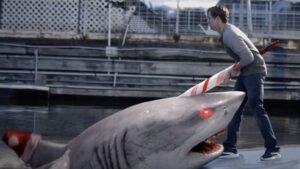
Killer Sofa (2019)
While this list is unfortunately coming to an end and is missing hundreds upon hundreds of other uniquely bad yet enjoyable films that I wish I could get to, it would seem best to leave off on a strong and very recent note.
Bernardo Rao’s direct-to-DVD comedy horror film, Killer Sofa, comes to us from the land of the kiwis and follows a disgraced rabbi by the name of Jack, who discovers an evil spirit that is inhabiting an old recliner chair. The recliner is sold, and Jack must track down the chair with the help of a voodoo mistress in order to destroy it and the evil it possesses.
One of Killer Sofa’s ultimate strengths is leaning into the aspects of its comedy much more than its horror, imbuing it with a strong sense of self-awareness and camp that can be murky in some of the other films on this list. This partially comes from the absurdity of the premise and the non-intimidating vessel that the evil spirit uses, whose slightly anthropomorphic look is boosted by the placement of two furniture buttons that appear as eyes. These “eyes” are emphasized in many shots and help to add a bit of personality to the chair, which is meant to feel a range of jealous emotions throughout the film.
The distributor of Killer Sofa is a company by the name of High Octane Pictures, and a quick look at their website gives a glimpse of hope for the future of contemporary B movies. They are only one of many companies that are producing and distributing these low budget B movies, alongside others such as The Asylum and Gravitas Ventures, which exist as indicators of a still-ignored industry’s ability to stay afloat with the tech and channels of new media.

The culture of watching films because they are so bad that they become fun and humorous experiences is nothing new. MST3K and Rifftrax have made hate-watching with friends a regular pastime for a more niche yet still growing audience that has exploded at exponential levels with the expansion and accessibility of the internet. Not only has the tech to make the kinds of films that appear on this list become more easily available to the average person, but the channels in which they can be distributed have grown too. With Amazon Prime allowing practically any form of content to be uploaded to their site and made available to watch with only a subscription as well as the wave of reaction content creators that boomed with the growing popularity of YouTube as a video hosting site, these films and the culture of enjoying them in their absurdity and low quality continues to grow and become a much more mainstream — as well as meta — community and endeavor.
While this mostly has been a positive effect, it has escalated the number of productions that get made as more people become filmmakers in hopes of having the next, underground cult hit. This has reached the same consequence as the mainstreams of media have, and the marketplace has become a ridiculously saturated landscape. We must again pick and choose what we consume and hope to enjoy. Although it was inevitable, as it has quickly become absorbed as a contemporary aspect of the human condition, the tradition of sitting down to watch a terrible B movie to appreciate the creations of those on the far sidelines of the film industry is one that has retained its capacity for being a good time and will continue to do so for years to come.
